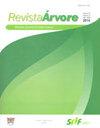SLUDGE FROM RICE PARBOILING WASTEWATER TREATMENT PLANT AS ALTERNATIVE SUBSTRATE FOR THE PRODUCTION OF Araucaria angustifolia SEEDLINGS
IF 0.8
4区 农林科学
Q4 FORESTRY
引用次数: 0
Abstract
ABSTRACT The sludge produced by rice parboiling wastewater treatment plants has substantial amounts of nutrients and organic matter, therefore requiring proper environmental disposal. One option is to use it as an alternative substrate for the production of forest species seedlings. This study aimed to assess the viability of using the sludge from rice parboiling wastewater as an alternative substrate for the production of Araucaria angustifolia (Bertol.) O. Kuntze seedlings. A. angustifolia seeds were kept in vermiculite until sprouting, then transferred to polyethylene bags filled with five different substrates (treatments): 100% sand (T1); 75% sand and 25% sludge (T2); 50% sand and 50% sludge (T3); 25% sand and 75% sludge (T4); 100% sludge (T5). Each treatment had 10 replicates (bag with one seedling). Shoot system growth, hypocotyl diameter, root system growth and biomass were evaluated at 94, 180, and 300 days of growth. Data were subjected to Analysis of Variance (ANOVA) followed by Tukey test with a significance level of 5%. Seedlings’ growth was similar on treatments containing 25%, 50%, and 75% sludge, while 100% sand and 100% sludge resulted in less growth at 300 days. In conclusion, the sludge from rice parboiling wastewater is suitable as an alternative substrate, and the ratio of 25% sand + 75% sludge could be recommended, for exploit larger amounts of the residue.水稻沸煮废水处理厂污泥作为生产紫砂苗的替代基质
稻谷沸煮废水处理厂产生的污泥含有大量的营养物质和有机物,因此需要适当的环境处理。一种选择是将其用作生产森林物种幼苗的替代基质。本研究的目的是评估利用大米沸腾废水中的污泥作为生产阿劳卡aria angustifolia (Bertol.)的替代底物的可行性。O. Kuntze幼苗。在蛭石中保存安瓜种子直到发芽,然后转移到聚乙烯袋中,装满五种不同的基质(处理):100%沙子(T1);75%砂和25%污泥(T2);50%砂和50%污泥(T3);25%砂75%泥(T4);100%污泥(T5)。每个处理10个重复(每袋1株苗)。在生长94、180和300 d时,测定茎系生长、下胚轴直径、根系生长和生物量。数据进行方差分析(ANOVA),然后进行Tukey检验,显著性水平为5%。含沙量为25%、50%和75%的处理幼苗生长相似,而含沙量为100%和含沙量为100%的处理幼苗生长较差。综上所述,稻谷沸煮废水污泥可作为替代基质,建议采用25%的砂+ 75%的污泥的比例,以开发更大量的残渣。
本文章由计算机程序翻译,如有差异,请以英文原文为准。
求助全文
约1分钟内获得全文
求助全文
来源期刊

Revista Arvore
FORESTRY-
CiteScore
1.00
自引率
0.00%
发文量
32
审稿时长
4-8 weeks
期刊介绍:
A Revista Árvore é um veículo de comunicação científica da Sociedade de Investigações Florestais – SIF. O jornal é de acesso gratuito, revisado por pares, que publica bimestralmente trabalhos científicos originais no campo da Ciência Florestal. As áreas temáticas para publicação são: Ambiência e Conservação da Natureza, Manejo Florestal, Silvicultura e Tecnologia da Madeira e Utilização de Produtos Florestais.
A política editorial visa manter alta conduta ética em relação à publicação e aos seus funcionários, rigor na qualidade dos artigos científicos, seleção de revisores qualificados, respeito profissional aos autores e processo de tomada de decisão imparcial. A Revista Árvore publica artigos apenas em inglês.
Artigos de revisão podem ser publicados se houver uma discussão relevante resumindo o estado da arte sobre o assunto. A revisão estrita da literatura não é aceita.
 求助内容:
求助内容: 应助结果提醒方式:
应助结果提醒方式:


